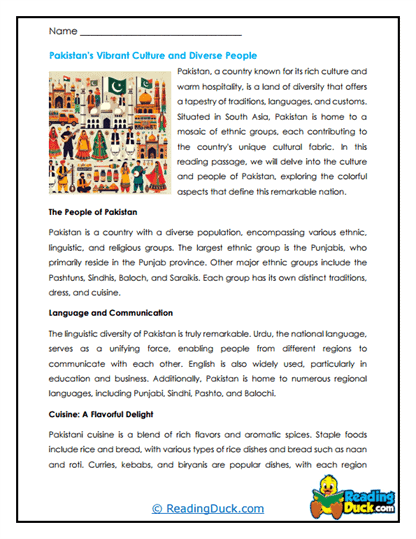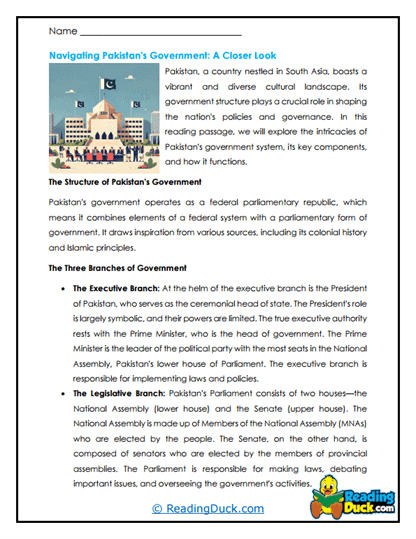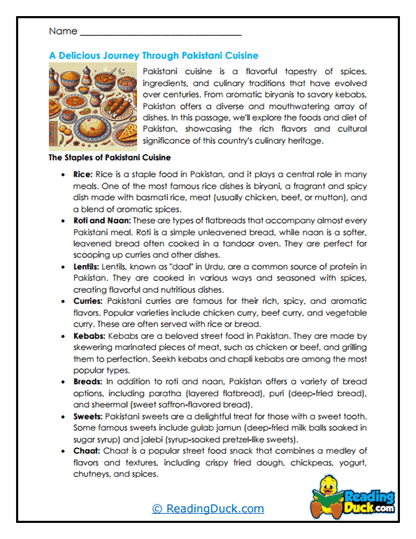Pakistan Worksheets
About Our Pakistan Worksheets
Our collection of Pakistan worksheets offers a comprehensive and engaging exploration of a country rich in history, culture, and geographical diversity. These worksheets, which belong under the category of Social Studies: World History, allow students to delve into various aspects of Pakistan, from its ancient civilizations and complex history to its vibrant culture and significant landmarks. Each worksheet set is thoughtfully designed to reinforce key concepts and encourage critical thinking through a variety of question formats and visually appealing content.
Each worksheet set includes:
- Multiple Choice Questions: These questions assess students' understanding of the reading passage by offering several answer options, reinforcing essential facts and concepts about Pakistan’s history, culture, and geography.
- Short Answer Questions: In this section, students are encouraged to write their own answers based on the reading passage. This format allows students to express their understanding in their own words, deepening their comprehension of the material.
- Open-Ended Questions: These questions prompt students to provide personal input, opinions, or reflections related to the reading material. This format encourages students to connect the topic of Pakistan to their own experiences and broader understanding of world history.
An answer key is provided for every question sheet, making it easy for teachers and parents to review and assess students' work. All worksheets are available as PDF files, which can be easily viewed electronically, downloaded, and printed out for use in classrooms or homeschool settings.
Understanding Pakistan: A Tapestry of History, Culture, and Geography
Pakistan is a country with a deep historical legacy, a vibrant cultural heritage, and diverse landscapes. When introducing students to Pakistan, it’s important to cover its historical background, cultural richness, geographical significance, and notable landmarks. By exploring these aspects, students can gain a deeper understanding of how Pakistan has evolved into the nation it is today, with its unique place in world history.
Historical Overview
- Ancient Civilizations and Islamic Empires
- Indus Valley Civilization: Pakistan’s history is rooted in one of the world’s oldest civilizations, the Indus Valley Civilization, which flourished around 2500 BCE in the regions of modern-day Pakistan. The cities of Mohenjo-Daro and Harappa are known for their advanced urban planning, including well-organized streets, drainage systems, and impressive architecture. This civilization is a significant part of world history, providing early examples of social organization, trade, and culture.
- Islamic Influence: The region that is now Pakistan has been influenced by various Islamic empires throughout history, including the Ghaznavid Empire, the Delhi Sultanate, and the Mughal Empire. The Mughal Empire, in particular, left a lasting impact on the region with its contributions to art, architecture, and culture, evident in iconic structures like the Badshahi Mosque in Lahore. The spread of Islam in the region also shaped the cultural and religious landscape of Pakistan.
- Colonial Rule and Independence
- British Colonial Period: In the 19th century, the region came under British colonial rule as part of British India. The colonial period brought significant changes to the social, economic, and political structures of the region. The introduction of the English language, Western education, and infrastructure development are some of the legacies of British rule. However, the colonial era also saw the rise of nationalist movements that sought independence from British control.
- The Creation of Pakistan: The demand for a separate Muslim state led to the creation of Pakistan in 1947, following the partition of British India. Led by Muhammad Ali Jinnah, the movement for Pakistan was rooted in the desire for a nation where Muslims could practice their religion freely. The partition was marked by significant migration and communal violence, but it also led to the establishment of Pakistan as a sovereign state. Since independence, Pakistan has navigated challenges related to governance, regional tensions, and economic development.
Culture, Geography, and Government
- Cultural Richness
- Ethnic Diversity and Languages: Pakistan is a culturally diverse country with several ethnic groups, including Punjabis, Sindhis, Baloch, Pashtuns, and many others. This diversity is reflected in the country’s languages, with Urdu serving as the national language and English as the official language of government and education. Each region has its own cultural traditions, languages, and artistic expressions, contributing to the rich cultural mosaic of Pakistan.
- Religious and Cultural Festivals: Islam is the predominant religion in Pakistan, and Islamic traditions play a central role in the country’s culture. Important religious festivals include Eid al-Fitr, marking the end of Ramadan, and Eid al-Adha, commemorating the willingness of Ibrahim (Abraham) to sacrifice his son. Pakistan also celebrates national holidays such as Pakistan Day (March 23) and Independence Day (August 14), which are marked by parades, flag-hoisting ceremonies, and cultural performances.
- Geography and Natural Wonders
- Diverse Landscapes: Pakistan’s geography is incredibly diverse, ranging from the towering peaks of the Himalayas and the Karakoram Range in the north to the arid deserts of Balochistan and the fertile plains of the Punjab. The country is home to K2, the second-highest mountain in the world, as well as the Indus River, which has been a lifeline for civilizations in the region for thousands of years. Pakistan’s natural beauty includes stunning valleys like Hunza and Swat, and the Thar Desert, one of the largest deserts in the world.
- Landmarks and Heritage Sites: Pakistan is rich in historical and cultural landmarks, many of which are UNESCO World Heritage Sites. These include the ancient ruins of Mohenjo-Daro, the Buddhist ruins at Takht-i-Bahi, and the Lahore Fort and Shalimar Gardens, which reflect the grandeur of the Mughal era. These sites are not only significant for their historical value but also attract tourists from around the world, contributing to Pakistan’s cultural and economic landscape.
- Government and Economy
- Islamic Republic: Pakistan is an Islamic republic with a parliamentary system of government. The President serves as the head of state, while the Prime Minister is the head of government. The country is divided into four provinces—Punjab, Sindh, Khyber Pakhtunkhwa, and Balochistan—each with its own provincial government. Pakistan’s political landscape has been shaped by periods of military rule, but it has maintained a functioning democracy since the early 2000s.
- Economic Challenges and Growth: Pakistan’s economy is diverse, with key sectors including agriculture, textiles, manufacturing, and services. The country is a major producer of cotton, rice, and wheat, and its textile industry is one of the largest in the world. However, Pakistan faces economic challenges such as inflation, energy shortages, and external debt. Despite these challenges, Pakistan continues to show potential for growth, particularly in areas such as information technology and renewable energy.
Traveling to Pakistan: What You Need to Know
Traveling to Pakistan offers a unique experience, from exploring ancient historical sites to enjoying the natural beauty of its mountains and valleys. Here’s what you need to know to make the most of your visit:
- Cultural Etiquette
- Respecting Traditions: Pakistan is a country with deep-rooted cultural and religious traditions. When visiting, it’s important to dress modestly, particularly in rural areas and when visiting religious sites. Women are advised to wear long sleeves and headscarves when entering mosques or other religious places. Greetings are an important part of Pakistani culture, with handshakes being common among men, while women may prefer a nod or verbal greeting.
- Language and Communication: Urdu is the national language, but English is widely spoken, especially in urban areas and among the educated population. Learning a few basic Urdu phrases can be helpful and is often appreciated by locals. In Pakistan, it’s common to address people with titles like “Mr.,” “Mrs.,” or “Doctor,” followed by their last name, as a sign of respect.
- Navigating Pakistan
- Transportation: Pakistan has a well-connected transportation system, including domestic flights, trains, and buses. In major cities like Karachi, Lahore, and Islamabad, taxis, buses, and ride-sharing services like Uber are widely available. For long-distance travel, domestic flights are the most efficient way to explore the country. The Karakoram Highway, often referred to as the Eighth Wonder of the World, offers a spectacular journey through the northern mountains.
- Safety and Health: Pakistan is generally safe for travelers, but it’s important to stay informed about any travel advisories and to follow local advice, especially in remote areas. It’s advisable to drink bottled water and be cautious with food, particularly street food. Make sure your vaccinations are up to date, including those for hepatitis, typhoid, and tetanus. It’s also a good idea to have travel insurance that covers health and unexpected events.
Tips for Using Pakistan Worksheets in Learning Curriculums
Teachers and parents can use these Pakistan worksheets creatively to enhance students’ understanding of this culturally rich and historically significant country:
- Cross-Curricular Integration - Integrate the Pakistan worksheets into broader lessons on world history, geography, and cultural studies. For example, students can explore the influence of the Mughal Empire on South Asian art and architecture or examine the impact of British colonial rule on Pakistan’s political and economic systems. This approach helps students understand the interconnectedness of historical events and cultural influences.
- Cultural Exploration Projects - Use the worksheets as a starting point for exploring Pakistan’s cultural diversity. Assign students to research and present on topics such as traditional Pakistani music and dance, the significance of Sufism in Pakistan, or the role of cricket in Pakistani society. Students can create visual presentations, participate in a mock festival celebration, or even try their hand at cooking a traditional Pakistani dish, making the learning experience interactive and engaging.
- Debate and Discussion - Encourage students to engage in debates or discussions based on topics covered in the worksheets. For instance, students can debate the benefits and challenges of Pakistan’s economic relationship with China or discuss the impact of environmental issues on Pakistan’s agricultural sector. This fosters critical thinking and allows students to explore different perspectives on important historical and cultural issues.
- Interactive Learning Activities - Incorporate technology by having students create digital presentations or interactive maps based on their worksheet activities. They can use tools like Google Earth to explore Pakistan’s geography or create a multimedia presentation on the history of the Indus Valley Civilization. This engages students in a more dynamic learning experience and enhances their technological skills.
By using these worksheets creatively, teachers and parents can help students gain a deeper appreciation for Pakistan’s rich history, culture, and global significance, making their learning experience both informative and enjoyable.









